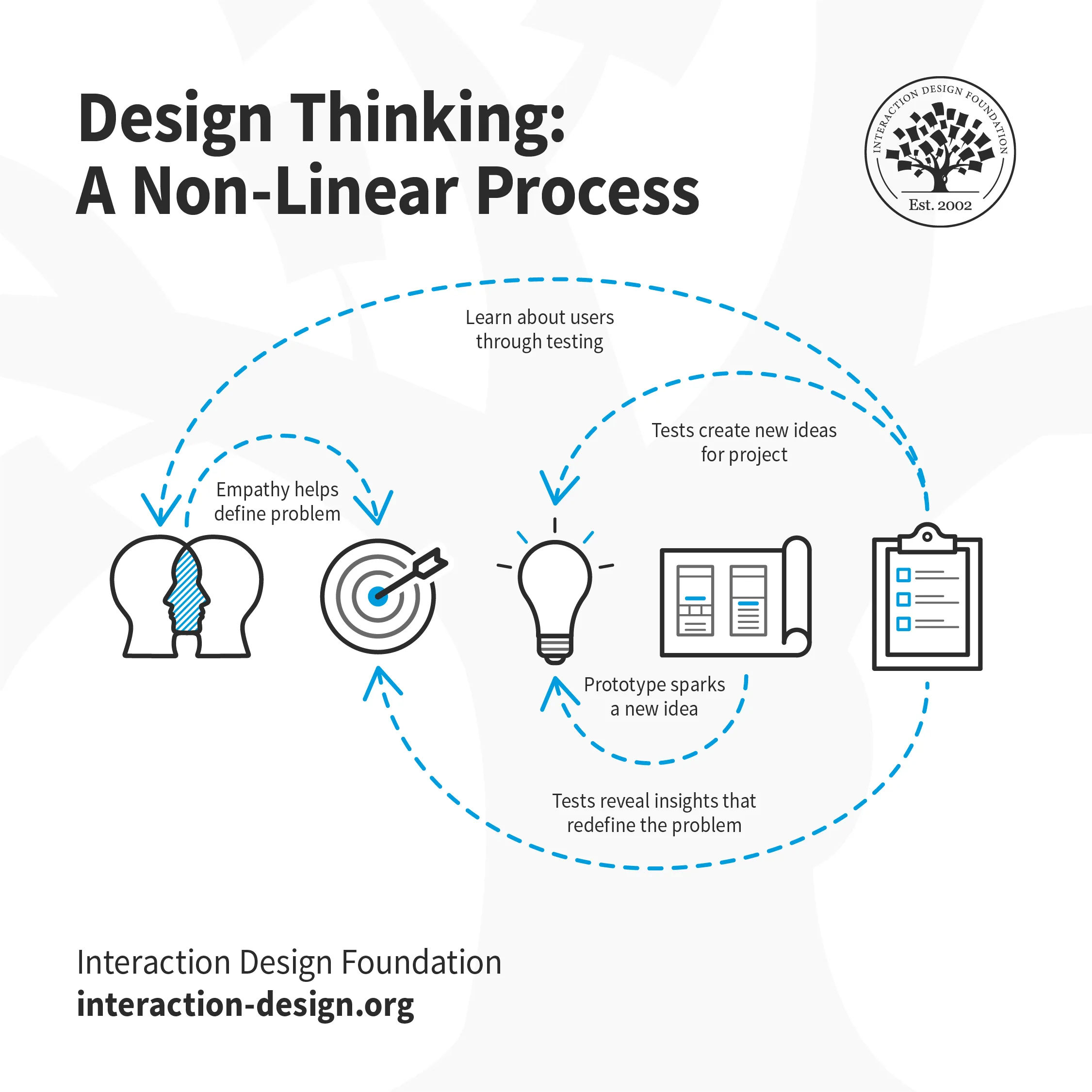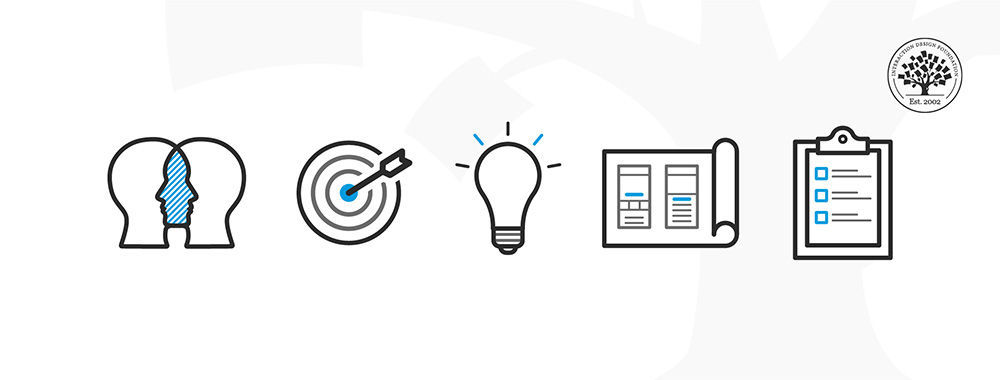Design thinking is a methodology that provides a solution-based approach to solving problems. It’s beneficial when used to tackle complex problems that are ill-defined or unknown—because it serves to understand the human needs involved, reframe the problem in human-centric ways, create numerous ideas in brainstorming sessions, and adopt a hands-on approach to prototyping and testing. When you know how to apply the five stages of design thinking, you will be empowered because you can apply the methodology to solve complex problems in our companies, our countries, and worldwide.
Design thinking is a non-linear, iterative process that can have anywhere from three to seven phases, depending on whom you talk to. We focus on the five-stage design thinking model proposed by the Hasso Plattner Institute of Design at Stanford (the d.school) because they are world-renowned for the way they teach and apply design thinking.
The five stages of design thinking, according to the d.school, are:
- Empathize: research your users’ needs.
- Define: state your users’ needs and problems.
- Ideate: challenge assumptions and create ideas.
- Prototype: start to create solutions.
- Test: try your solutions out.
Let’s dive into each stage of the design thinking process.
Stage 1: Empathize—Research Your Users’ Needs

Empathize: the first phase of design thinking, where you gain real insight into users and their needs.
The first stage of the design thinking process focuses on user-centric research. You want to gain an empathic understanding of the problem you are trying to solve. Consult experts to find out more about the area of concern and conduct observations to engage and empathize with your users. You may also want to immerse yourself in your users’ physical environment to gain a deeper, personal understanding of the issues involved—as well as their experiences and motivations. Empathy is crucial to problem-solving and a human-centered design process as it allows design thinkers to set aside their own assumptions about the world and gain real insight into users and their needs. Depending on time constraints, you will gather a substantial amount of information to use during the next stage. The main aim of the Empathize stage is to develop the best possible understanding of your users, their needs, and the problems that underlie the development of the product or service you want to create.
Stage 2: Define—State Your Users’ Needs and Problems

Define: the second phase of design thinking, where you define the problem statement in a human-centered manner.
In the Define stage, you will organize the information you have gathered during the Empathize stage. You’ll analyze your observations to define the core problems you and your team have identified up to this point. Defining the problem and problem statement must be done in a human-centered manner. For example, you should not define the problem as your own wish or need of the company: “We need to increase our food-product market share among young teenage girls by 5%.” You should pitch the problem statement from your perception of the users’ needs: “Teenage girls need to eat nutritious food in order to thrive, be healthy, and grow.” The Define stage will help the design team collect great ideas to establish features, functions, and other elements to solve the problem at hand—or, at the very least, allow real users to resolve issues themselves with minimal difficulty. In this stage, you will start to progress to the third stage, the ideation phase, where you ask questions to help you look for solutions: “How might we encourage teenage girls to perform an action that benefits them and also involves your company’s food-related product or service?” for instance.
Stage 3: Ideate—Challenge Assumptions and Create Ideas

Ideate: the third phase of design thinking, where you identify innovative solutions to the problem statement you’ve created.
During the third stage of the design thinking process, designers are ready to generate ideas. You’ve grown to understand your users and their needs in the Empathize stage, and you’ve analyzed your observations in the Define stage to create a user-centric problem statement. With this solid background, you and your team members can start to look at the problem from different perspectives and ideate innovative solutions to your problem statement. There are hundreds of ideation techniques you can use—such as Brainstorm, Brainwrite, Worst Possible Idea, and SCAMPER. Brainstorm and Worst Possible Idea techniques are typically used at the start of the ideation stage to stimulate free thinking and expand the problem space. This allows you to generate as many ideas as possible at the start of ideation. You should pick other ideation techniques towards the end of this stage to help you investigate and test your ideas and choose the best ones to move forward with—either because they seem to solve the problem or provide the elements required to circumvent it.
Stage 4: Prototype—Start to Create Solutions

Prototype: the fourth phase of design thinking, where you identify the best possible solution.
The design team will now produce a number of inexpensive, scaled down versions of the product (or specific features found within the product) to investigate the key solutions generated in the ideation phase. These prototypes can be shared and tested within the team itself, in other departments or on a small group of people outside the design team. This is an experimental phase, and the aim is to identify the best possible solution for each of the problems identified during the first three stages. The solutions are implemented within the prototypes and, one by one, they are investigated and then accepted, improved or rejected based on the users’ experiences. By the end of the Prototype stage, the design team will have a better idea of the product’s limitations and the problems it faces. They’ll also have a clearer view of how real users would behave, think and feel when they interact with the end product.
Stage 5: Test—Try Your Solutions Out

Test: the fifth and final phase of the design thinking process, where you test solutions to derive a deep understanding of the product and its users.
esigners or evaluators rigorously test the complete product using the best solutions identified in the Prototype stage. This is the final stage of the five-stage model; however, in an iterative process such as design thinking, the results generated are often used to redefine one or more further problems. This increased level of understanding may help you investigate the conditions of use and how people think, behave and feel towards the product, and even lead you to loop back to a previous stage in the design thinking process. You can then proceed with further iterations and make alterations and refinements to rule out alternative solutions. The ultimate goal is to get as deep an understanding of the product and its users as possible.
Did You Know Design Thinking is a Non-Linear Process?
We’ve outlined a direct and linear design thinking process here, in which one stage seemingly leads to the next with a logical conclusion at user testing. However, in practice, the process is carried out in a more flexible and non-linear fashion. For example, different groups within the design team may conduct more than one stage concurrently, or designers may collect information and prototype throughout each stage of the project to bring their ideas to life and visualize the problem solutions as they go. What’s more, results from the Test stage may reveal new insights about users which lead to another brainstorming session (Ideate) or the development of new prototypes (Prototype).

It is important to note the five stages of design thinking are not always sequential. They do not have to follow a specific order, and they can often occur in parallel or be repeated iteratively. The stages should be understood as different modes which contribute to the entire design project, rather than sequential steps. © Teo Yu Siang and the Interaction Design Foundation, CC BY-NC-SA 3.0. The design thinking process should not be seen as a concrete and inflexible approach to design; the component stages identified should serve as a guide to the activities you carry out. The stages might be switched, conducted concurrently or repeated several times to gain the most informative insights about your users, expand the solution space and hone in on innovative solutions. This is one of the main benefits of the five-stage model. Knowledge acquired in the latter stages of the process can inform repeats of earlier stages. Information is continually used to inform the understanding of the problem and solution spaces, and to redefine the problem itself. This creates a perpetual loop, in which the designers continue to gain new insights, develop new ways to view the product (or service) and its possible uses and develop a far more profound understanding of their real users and the problems they face.


